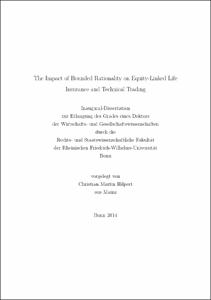Hilpert, Christian Martin: The Impact of Bounded Rationality on Equity-Linked Life Insurance and Technical Trading. - Bonn, 2014. - Dissertation, Rheinische Friedrich-Wilhelms-Universität Bonn.
Online-Ausgabe in bonndoc: https://nbn-resolving.org/urn:nbn:de:hbz:5-37472
Online-Ausgabe in bonndoc: https://nbn-resolving.org/urn:nbn:de:hbz:5-37472
@phdthesis{handle:20.500.11811/5961,
urn: https://nbn-resolving.org/urn:nbn:de:hbz:5-37472,
author = {{Christian Martin Hilpert}},
title = {The Impact of Bounded Rationality on Equity-Linked Life Insurance and Technical Trading},
school = {Rheinische Friedrich-Wilhelms-Universität Bonn},
year = 2014,
month = oct,
note = {This dissertation deals with the impact of investor behavior for life insurance and technical trading. The first part of this dissertation is concerned with equity-linked life insurance contracts, while the second part of this dissertation is analyses technical trading of stocks.
Part I of this dissertation is split into two chapters. In Chapter One, I study the effect of secondary markets on equity-linked life insurance contracts with surrender guarantees for policyholders with bounded rationality. Many equity-linked life insurance products offer the possibility to surrender policies prematurely. Secondary markets for policies with surrender guarantees influence both policyholders and insurers. I show that secondary markets lead to a gap in policy value between insurer and policyholder. Insurers increase premiums to adjust for higher surrender rates of customers and optimized surrender behavior by investors acquiring the policies on secondary markets. Hence, the existence of secondary markets is not necessarily profitable for the primary policyholders. The result depends on the demand for and the supply of the contracts brought to the secondary markets.
In Chapter Two, I study the effect of policyholder's risk preferences on equity-linked life insurance contracts with surrender guarantees. While the first chapter takes the reasons for bounded rationality as exogenous, in the second chapter I model the risk preferences of the policyholder explicitly. I value equity-linked life insurance contracts with surrender guarantee for boundedly rational policyholders with loss averse preferences as in Tversky and Kahneman (1991). Our policyholders' surrender behavior deviates from both the standard optimal stopping approach and expected utility implied surrender behavior in two ways: Firstly, the equity level for exercise changes as our policyholders surrender earlier if the underlying equity underperforms. Secondly, policyholders surrender to avoid the insurance becoming a loss, which reshapes the surrender area and creates surrender peaks if the surrender benefit reaches the policyholders' reference point.
Part II of this dissertation is concerned with technical trading of stocks. Chapter Three studies technical analysis from the perspective of Cumulative Prospect Theory. Technical analysts, or chartists, aim at predicting future prices from past prices. Sometimes they draw resistance levels and Moving Average (MA) lines into stock price charts. I show that the widely employed MA cross-over rule is consistent with prospect theory preferences even when prices do not move in trends and when stock trading is unattractive to all rational expected utility maximizers. While chartists often argue that market participants being less than fully rational explains why technical analysis is profitable, this chapter shows that technical analysis may be attractive - even when not profitable - to investors who are less than fully rational.},
url = {https://hdl.handle.net/20.500.11811/5961}
}
urn: https://nbn-resolving.org/urn:nbn:de:hbz:5-37472,
author = {{Christian Martin Hilpert}},
title = {The Impact of Bounded Rationality on Equity-Linked Life Insurance and Technical Trading},
school = {Rheinische Friedrich-Wilhelms-Universität Bonn},
year = 2014,
month = oct,
note = {This dissertation deals with the impact of investor behavior for life insurance and technical trading. The first part of this dissertation is concerned with equity-linked life insurance contracts, while the second part of this dissertation is analyses technical trading of stocks.
Part I of this dissertation is split into two chapters. In Chapter One, I study the effect of secondary markets on equity-linked life insurance contracts with surrender guarantees for policyholders with bounded rationality. Many equity-linked life insurance products offer the possibility to surrender policies prematurely. Secondary markets for policies with surrender guarantees influence both policyholders and insurers. I show that secondary markets lead to a gap in policy value between insurer and policyholder. Insurers increase premiums to adjust for higher surrender rates of customers and optimized surrender behavior by investors acquiring the policies on secondary markets. Hence, the existence of secondary markets is not necessarily profitable for the primary policyholders. The result depends on the demand for and the supply of the contracts brought to the secondary markets.
In Chapter Two, I study the effect of policyholder's risk preferences on equity-linked life insurance contracts with surrender guarantees. While the first chapter takes the reasons for bounded rationality as exogenous, in the second chapter I model the risk preferences of the policyholder explicitly. I value equity-linked life insurance contracts with surrender guarantee for boundedly rational policyholders with loss averse preferences as in Tversky and Kahneman (1991). Our policyholders' surrender behavior deviates from both the standard optimal stopping approach and expected utility implied surrender behavior in two ways: Firstly, the equity level for exercise changes as our policyholders surrender earlier if the underlying equity underperforms. Secondly, policyholders surrender to avoid the insurance becoming a loss, which reshapes the surrender area and creates surrender peaks if the surrender benefit reaches the policyholders' reference point.
Part II of this dissertation is concerned with technical trading of stocks. Chapter Three studies technical analysis from the perspective of Cumulative Prospect Theory. Technical analysts, or chartists, aim at predicting future prices from past prices. Sometimes they draw resistance levels and Moving Average (MA) lines into stock price charts. I show that the widely employed MA cross-over rule is consistent with prospect theory preferences even when prices do not move in trends and when stock trading is unattractive to all rational expected utility maximizers. While chartists often argue that market participants being less than fully rational explains why technical analysis is profitable, this chapter shows that technical analysis may be attractive - even when not profitable - to investors who are less than fully rational.},
url = {https://hdl.handle.net/20.500.11811/5961}
}






